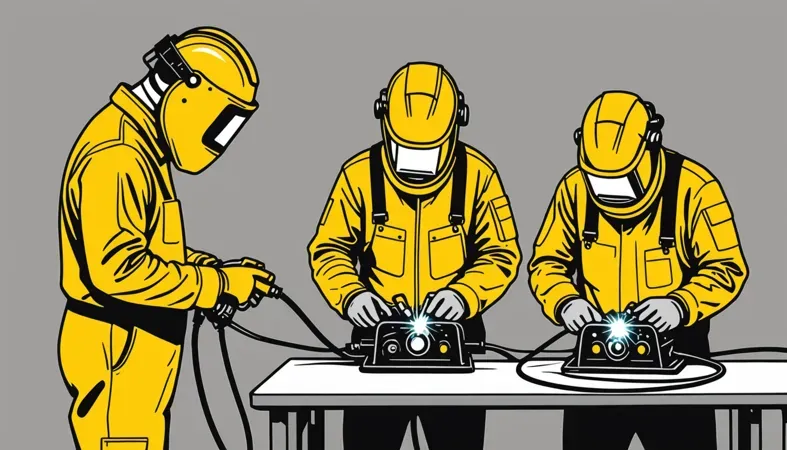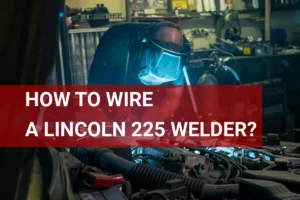How to Set Up a MIG Welder? Essential Steps, Types, and Tips
Published on: March 28, 2025 | Last modified: March 4, 2025
By: Joe Carter
A MIG welder is a tool that uses a continuous wire feed to join pieces of metal together. It’s user-friendly, making it great for beginners and pros alike.
You may be wondering how to set up a mig welder. It’s important to do this right for safety and to ensure good welds. I’ve learned the hard way that a proper setup saves time and headaches later.
In this guide on how to set up a mig welder, we’ll cover the types of MIG welders, prerequisites for setup, step-by-step instructions, important precautions, factors affecting the setup, common problems, and some advanced tips for aftercare. You’ll know what adjustments your machine needs and what conditions to monitor for perfect welds.
Contents
- How to Set Up A MIG Welder?
- What is a MIG Welder?
- Types Of MIG Welders
- Prerequisites
- Precautions
- Steps to Set Up a MIG Welder
- Types Of MIG Welding Processes
- Factors Influencing MIG Welder Setup
- Typical Problems to Be Aware Of
- Common Accessories for MIG Welder Setup
- Top Benefits You Can Expect From MIG Welding
- Applications Across Different Fields
- Alternatives for Setting Up a MIG Welder
- Frequently Asked Questions (FAQs)
- Conclusion
- References
How to Set Up A MIG Welder?
A MIG welder is a machine that joins metals using a wire feed. To set up a MIG welder, connect gas, adjust the voltage to 18-20 volts, and set wire speed to 200-300 inches per minute. It’s easy for car repairs and metal fabrication.
Exploring various welding technologies, one might consider the evolving costs and features of different equipment such as laser welders.
What is a MIG Welder?
A MIG welder, or Metal Inert Gas welder, is a versatile tool for welding metals. It uses a continuous wire feed and a shielding gas, typically argon or carbon dioxide, to protect the weld. MIG welding is efficient, often producing speeds of 10 to 25 inches per minute (25 to 64 Cm/min). This method accounts for about 35% of total welding production in the U.
S.!
To set up a MIG welder, first, choose the right wire. Typically, a 0.030-inch (0.76 Mm) wire works best for short, thin metals. Adjust the voltage and wire feed speed based on material thickness. I remember setting one up; I matched those settings to avoid burn-through.
I’ve heard friends share how it worked for them in tricky situations, like welding 1/4-inch (6.35 Mm) steel. They always emphasize the importance of adjusting the MIG welder settings for a clean, strong weld. You need to match the voltage with your wire feed; this makes setting your MIG welder a game changer for quality results.
Types Of MIG Welders
-
Gas Metal Arc Welders
Gas Metal Arc Welders (GMAW) use shielding gas to protect the weld from contamination. To get started, connect a gas tank to the welder and adjust the flow rate. Set the correct voltage and wire speed based on your material thickness—usually between 0.8 mm to 1.2 mm in diameter for the filler wire. Choosing the right welding machine can significantly enhance efficiency on pipeline projects, as these tasks demand specific welding techniques and equipment. For more information, explore the best welding machine for pipeline.
.
-
Inverter MIG Welders
Inverter MIG Welders are lightweight and portable, perfect for various tasks. To set one up, connect the input power and plug it in. Input the settings based on your metal type and thickness—generally, 12 volts to 25 volts works for many applications.
-
Flux-cored MIG Welders
Flux-Cored MIG Welders don’t require external shielding gas, making them ideal for outdoor work. To set this welder up, install the appropriate flux-cored wire and adjust the voltage and wire feed rate, typically around 11 volts to 24 volts depending on the project. For those interested in more detailed setups, you can explore various ways on how to wire a Lincoln 225 welder.
-
Multi-process Welders
Multi-Process Welders combine MIG, TIG, and stick welding in one machine. To use it for MIG welding, select the MIG function on the control panel. Follow the setup instructions to choose the wire size and voltage, which typically ranges from 14 volts to 21 volts.
-
Industrial MIG Welders
Industrial MIG Welders are robust machines designed for heavy-duty tasks. To set one up, connect it to a suitable power source and configure the settings according to the metal being worked on, usually requiring a wire feed speed of about 400 inches per minute.
We have now covered the types of MIG welders. Next, we will discuss the necessary prerequisites.

Prerequisites
What do you need to get started with your MIG welder setup?
- MIG Welder Machine: You’ll need a quality MIG welder, like the Lincoln Electric MIG Pack 180. This machine provides 180 amps of power, ideal for various metals.
- Welding Wire: Get .030 inches (.76 Mm) ER70S-6 wire, such as Hobart MIG Wire. This size and type ensure a strong weld on mild steel.
- Shielding Gas: Use a 75% Argon and 25% CO2 gas mix, typically in a 20 cu ft (567 L) tank. This mix is essential for preventing oxidation during welding.
- Welding Cart: Consider a portable cart, like the Eastwood MIG Welder Cart. It makes moving your setup easy and keeps your workspace organized.
- Welding Nozzles: Purchase a .030-.035 inch (0.8-0.9 Mm) contact tip, such as the Miller Nozzle, to ensure proper wire feed and gas shield coverage.
We covered necessary requirements, guidelines, and tools here. We will now cover safety measures and precautions.
Precautions
Let’s cover crucial safety measures for your MIG welding setup.
- Wear Proper PPE: Always use a welding helmet, gloves, and long sleeves to protect yourself from harmful sparks. Consider styles like the Esab Sentinel A50 for Lynx optics.
- Ventilate Workspace: Ensure good airflow to prevent harmful gas buildup, especially carbon monoxide (CO) and ozone. A fan like the Vornado 630 helps maintain airflow.
- Check for Flammable Materials: Remove any combustible items, such as rags and wood. Ignition can occur quickly; keep your area safe!
- Power Off When Setting Up: Always turn off the power before adjusting equipment to prevent accidental arcs and burns. I highly recommend the Andreabryan MIG120 machine for user-friendly safety.
Remember, I take safety seriously—precautions save lives!
We have now covered important precautions for safe MIG welding. The next section will outline the steps to set up a MIG welder.
Steps to Set Up a MIG Welder
Here are the essential steps to set up your MIG welder.
-
Connect the Gas Supply
First, connect the gas supply to your MIG welder. If you’re using argon or CO2, ensure your cylinder is secured upright. Open the gas flow adjustment valve until you hear a soft hiss; it’s usually set at 10-15 psi (69-103 Kpa). Using the correct gas mix significantly impacts your weld quality.
After setting the gas, check the regulator gauge to confirm it’s reading correctly. Adjust if needed, as a steady flow prevents contamination of the weld area. Too much gas can disrupt the weld puddle, while too little can cause poor shielding. Fine-tuning this step affects your machine’s performance.
-
Install the Wire Feed
Next, install the MIG wire by opening the welder’s wire compartment. Choose the correct wire diameter; 0.030 inches (0.76 Mm) is best for general welding. Thread the wire through the wire feed roller and into the gun nozzle, ensuring it’s securely gripped. Cut the wire at a 45-degree angle for smooth feeding.
Adjust the wire feed speed based on your material thickness. For thin metal, use about 6-8 inches per minute (152-203 Mm/min); for thicker plate, use a faster speed. Incorrect settings can lead to burn-through or lack of penetration, and you don’t want that!
-
Set Voltage and Wire Speed
Now, adjust the voltage and wire feed settings on your MIG welder according to the material you’re welding. For thicker materials, you’ll need a higher voltage, typically 22-28 volts (V) for 1/4 inch (6.35 Mm) steel. Your machine’s manual will have a chart for these settings; consult it while making adjustments.
Also, adjust the wire speed proportionally to the voltage. For example, at a 23V setting, a wire speed of about 300 inches per minute (7620 Mm/min) is ideal. The right settings lead to smoother, cleaner welds, so keep a notepad handy for your preferred settings!
-
Test Your Welder
Finally, it’s time to test your welder! Grab some scrap metal and start a few beads. Look for a steady arc and adjust the voltage and feed speed if necessary. If the weld appears too spattery, decrease the wire speed. If it doesn’t stick, consider increasing the voltage.
Pay attention to the cooling phase as well. Allow the metal to cool down since overheating can warp your base material. This testing phase is crucial for ensuring everything’s set correctly, as practice always improves your skills! Plus, it helps you identify settings that best suit your style.
That covers the steps for setting up a MIG welder. Let’s now take a look at different MIG welding processes.
Types Of MIG Welding Processes
Let’s move on to the types of MIG welding: Short Circuit Transfer, Globular Transfer, Spray Transfer, Pulsed MIG Welding, and Flat Position Welding.
-
Short Circuit Transfer
This method operates in short circuit mode, where the wire contacts the molten puddle. It’s ideal for thin materials, typically 24 gauge (0.6 Mm) and thicker. Set the voltage low, around 16-19 volts, and the wire feed speed between 250-350 inches per minute (Ipm).
-
Globular Transfer
Globular transfer occurs when the arc generates larger droplets of weld metal. It’s best for steel with a thickness of at least 0.125 inches (3.2 Mm). Use higher voltage settings around 20-26 volts and an amperage of 150-250 amps for good penetration.
-
Spray Transfer
In this mode, a fine mist of droplets transfers into the weld pool. It’s efficient for materials thicker than 0.25 inches (6.3 Mm). Set the welding voltage to about 24-30 volts, with a wire speed of approximately 400-600 ipm for a smooth finish.
-
Pulsed MIG Welding
Pulsed MIG combines short bursts of high and low power, allowing precise control and less heat distortion. This method works on both thin and thick materials, adjustable between 15-25 volts. It often requires specific pulse parameters, depending on the machine.
-
Flat Position Welding
This technique involves the workpiece flat on the table. It’s straightforward. For adjusting the welder, keep your voltage around 20-24 volts and a steady feed speed for better control. Ideal for beginners, it offers reasonable control while learning.
Factors Influencing MIG Welder Setup
What factors affect your MIG welder configuration? Let’s dive in!
-
Material Thickness
Adjust your settings based on material thickness. For metal under 3 mm (1/8 in), use lower voltage and wire feed speeds. Thicker materials need more power.
-
Type Of Material
Different materials require specific settings. Mild steel, aluminum, and stainless steel have unique welding characteristics that need tailored voltage and wire sizes.
-
Electrode Type
Your MIG welder’s wire must match the material. Use ER70S-6 for mild steel and ER4047 for aluminum. The electrode also affects your voltage and feed rates.
-
Environmental Conditions
Welding outdoors? Wind can disrupt your shielding gas, requiring adjustments. Choose calm areas or use windshields in breezy spots to ensure a clean weld.
-
Welder’s Skill Level
A beginner might start with lower settings for better control. Experienced welders adjust settings quickly for different projects, enhancing quality and speed.
Typical Problems to Be Aware Of
Let’s look at issues that can arise when using a MIG welder.
-
Inconsistent Arc Performance
The MIG welder might show unstable arcs. You can spot it by looking for erratic sparks. To solve this, check your voltage settings. Aim for 18-24 volts, depending on material thickness.
-
Burn-through on Thinner Materials
MIG welders can cause burn-through. If you notice puckers or holes, you’re applying too much heat. Lower your wire speed and adjust the voltage to match the base metal thickness.
-
Wire Feed Issues
Sometimes, the MIG welder experiences wire feed problems, like stuttering or jams. If it feels inconsistent, check for kinks in the wire and clear the feed path. A feed speed of 10-12 inches (25-30 Cm) per minute is ideal.
-
Gas Flow Problems
The MIG welder may struggle if gas flow is poor. You’ll hear hissing or see excess spatter while welding. A flow rate of 15-25 cubic feet per hour (Cfh) usually works well.
-
Welding Defects Such As Porosity
Pockets of gas in your weld, or porosity, can indicate a MIG welder issue. If you see pinholes, increase the shielding gas flow and check for drafts in your workspace.
Common Accessories for MIG Welder Setup
Enhance your MIG welding experience with these essential accessories.
| Accessory | Purpose | Recommended Type/Model | Typical Cost (USD) |
|---|---|---|---|
| Welding Helmet | Protects your eyes from UV radiation and sparks. | Jackson Safety BH3 | $50 – $250 |
| Welding Gloves | Protects your hands from heat and spatter. | Lincoln Electric Leather | $20 – $50 |
| Spool Gun | For feeding aluminum wire easily. | Miller Spoolmate 100 | $150 – $400 |
| Welding Tables | Provides a stable surface for your projects. | Lincoln Electric Portable Table | $100 – $300 |
| Magnetic Clamps | Holds metal pieces in position during welding. | DEWALT DWHT83827 | $10 – $30 |
Using these accessories can significantly improve your setup and welding experience. They help in maintaining safety and enhancing the quality of your work!
Top Benefits You Can Expect From MIG Welding
The biggest benefit of learning to set up a MIG welder is speed. I’ve had friends say how it helped them complete projects much quicker than other methods.
It also offers versatility with materials like steel, aluminum, and more. You’ll enjoy cleaner welds, less spatter, and easy operation. Plus, it’s great for beginners since welding machines require less practice than other welding types.
Applications Across Different Fields
I’ve used MIG welders for metal fabrication, but they have many applications, such as:
- Automotive Repair: MIG welders excel at fixing car body panels. Their ability to handle thin metals makes them a top choice in auto shops.
- HVAC Systems: MIG welders are essential for creating ductwork. Their quick setup boosts production line efficiency and keeps costs down, making them popular in HVAC projects.
- Metal Art Projects: Many artists use MIG welders to create intricate metal sculptures. Their versatility and ease of use allow creativity to flow freely, and you can find them in galleries everywhere.
- Manufacturing Machinery: MIG welding is vital for assembling manufacturing equipment. The speed and clean welds significantly improve productivity, making it a favorite in factories.

Alternatives for Setting Up a MIG Welder
There are several alternatives to achieve similar results without following the exact instructions on how to set up a MIG welder. For example, using a flux-cored welder, like the Lincoln Electric Handy MIG, can come in handy when gas isn’t available. Another option is a dual-shield MIG setup, which may be preferred for heavy-duty jobs.
From what I’ve encountered personally, you can also consider using a stick welder for tougher materials or situations where portability matters. Welding machines, like the Hobart Handler 140, allow you to adjust settings tailored to your project needs. These options could save you time and costs while getting your welding done right!
Frequently Asked Questions (FAQs)
Now let us look at some common questions I typically get asked about MIG welders.
What Should I Set My MIG Welder to?
You should set your MIG welder to the manufacturer’s recommended settings for the material thickness. Generally, for steel, a voltage of 18-20 volts (V) is common for 1/8 inch (3.2 Mm) material. Adjust wire feed speed based on the alloy type and the heat required to prevent burn-through.
How to Adjust a MIG Welder?
To adjust a MIG welder, you’ll need to set the voltage and wire feed speed according to the material being welded. For instance, thinner materials benefit from lower voltage—around 15-17 V for 16 gauge (1.6 Mm) steel—to avoid warping and distortion.
How to Set Current and Voltage in MIG Welding?
To set current and voltage in MIG welding, start with scrap metal for testing. A good rule of thumb is to aim for a current of about 1 amp per 0.001 inch (0.025 Mm) of material thickness, adjusting voltage accordingly to achieve a stable arc.
How to Determine the Right Wire Feed Speed for MIG Welding?
You determine the right wire feed speed for MIG welding by balancing it with voltage. A standard range is 200-400 inches per minute (Ipm) for different materials, but testing can optimize settings for a clean weld bead in your specific application.
What Are Common Problems When Using a MIG Welder?
Common problems when using a MIG welder include poor penetration, excessive spatter, and inconsistent arc. These issues often stem from incorrect settings. Ensuring proper voltage and wire speed and maintaining a clean work surface can help mitigate these problems.
What’s the Best Type Of Shielding Gas for MIG Welding?
The best type of shielding gas for MIG welding is a mix of Argon and CO2. For example, a 75% Argon and 25% CO2 blend works well for mild steel, ensuring a stable arc while minimizing spatter. The flow rate should typically be set between 15-20 cubic feet per hour (Cfh).
Conclusion
Phew, we covered a lot. We talked about what a MIG welder is, types of MIG welders, prerequisites, steps to set up a MIG welder, precautions, and the various MIG welding processes. Don’t forget the factors influencing MIG welder setup, the typical problems you might face, aftercare and inspection tips, plus the benefits and applications of MIG welding.
So, how to set up a MIG welder? Simply start by gathering your tools, checking the gas supply, setting the correct voltage, adjusting the feed speed, and ensuring you have the right filler material. All these steps ensure you get consistent results, whether you’re a beginner or a pro. Remember, understanding how to adjust your MIG welder settings can make a real difference in your welding journey.
For additional insights and tips on welding, you can explore more at What is Welding.
References
- Welding Institute (TWI): https://www.twi-global.com
Joe Carter is a retired welding professional with over 40 years of hands-on experience in the industry, spanning ship repair, structural welding, and even underwater projects. Joe is a master of MIG, TIG, and Stick welding. Passionate about mentoring the next generation of welders, Joe now shares his decades of expertise and practical insights to help others build rewarding careers in welding.
Metal Fabrication, MIG Welding, Safety Precautions, Welding, Welding Equipment, Welding Setup, Welding Table, Welding Techniques, Welding Tips, Welding Wire







